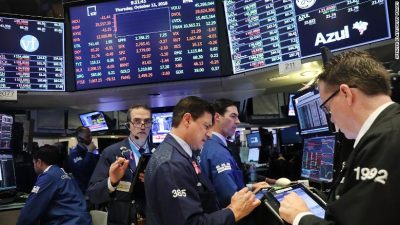Wall Street stocks fell in volatile trading on Friday, with the Nasdaq confirming it is in a bear market, as concerns of slowing economic growth led investors to flee stocks in high-valuation sectors such as technology and communication services.
The tech-heavy Nasdaq sank to a 15-month low, falling as much as 21.5 percent from its Aug. 29 high. The benchmark S&P 500 index, already on pace for its biggest percentage decline in December since the Great Depression, hit its lowest level since August 2017. The Dow Industrials fell to the lowest level since October 2017.
All three indexes swung between losses and gains of more than 1 percent. They received a momentary boost after New York Fed President John Williams said on CNBC that the Fed is open to reassessing its views and monitoring market signals that economic growth could fall short of expectations.
But those gains soon evaporated as economic worries again prevailed. Williams’ dovish comments could point to hidden concerns among some Fed policymakers, said Tim Ghriskey, investment strategist at Inverness Counsel in New York.
“(Williams’ comments) helped the markets for a while early on, and then it was just a sell-off after that,” Ghriskey said. “Part of that is when the Fed says something like they’re re-looking at things, there’s a concern that maybe the Fed knows something that we don’t know.”
Technology <.SPLRCT> and communication services <.SPLRCL> stocks bore the brunt of the sell-off, falling 2.3 percent and 2.7 percent, respectively.
The FAANG group of momentum stocks fared poorly. Facebook Inc <FB.O> shares tumbled 5.4 percent, Amazon.com Inc shares slid 4.8 percent and Netflix Inc <NFLX.O> shares sank 5.0 percent. Shares of both Apple Inc <AAPL.O> and Google parent Alphabet Inc <GOOGL.O> dropped more than 2 percent.
Turmoil in Washington injected further pessimism into U.S. stock markets. President Donald Trump said there was a very good chance a government funding bill, which included funding for a wall along Mexico border, would not pass the Senate.
“The market continues to react to the possibility of a government shutdown, fear of a domestic and global slowdown and general displeasure about the direction of Fed policy,” said Ryan Larson, head of U.S. equity trading at RBC Global Asset Management in Chicago.
The Dow Jones Industrial Average <.DJI> fell 271.91 points, or 1.19 percent, to 22,587.69, the S&P 500 <.SPX> lost 34.61 points, or 1.40 percent, to 2,432.81 and the Nasdaq Composite <.IXIC> dropped 154.57 points, or 2.37 percent, to 6,373.84.
For the second day in a row, more than 2,000 New York Stock Exchange and Nasdaq-listed stocks hit 52-week lows. The day before, nearly 3,000 stocks hit their low for the year, the most in any one day since October 2008.
The three indexes are already in a correction, having fallen more than 10 percent from their record closing highs. The Nasdaq confirmed it is in a bear market, which is marked when an index closes more than 20 percent below its recent closing high.
Adding to volatility was “quadruple-witching,” when options on stocks and indexes as well as futures on indexes and stocks expire. Trading volume is often high on “quadruple-witching” days.
Among Wall Street’s advancers were shares of Nike Inc <NKE.N>, which jumped 7.5 percent after the company’s quarterly results beat Wall Street estimates on strength in North America.
Declining issues outnumbered advancing ones on the NYSE by a 2.48-to-1 ratio; on Nasdaq, a 3.14-to-1 ratio favored decliners.
The S&P 500 posted no new 52-week highs and 115 new lows; the Nasdaq Composite recorded five new highs and 732 new lows.
(Reporting by April Joyner; Additional reporting by Medha Singh in Bengaluru; Editing by Shounak Dasgupta and Nick Zieminski)
NEW YORK (Reuters)

















